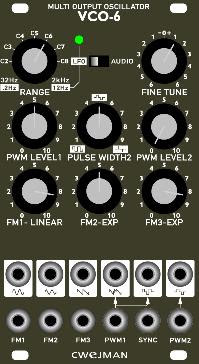I just saw this on the
My Synthesis Technology MOTM Analog Modular Synth blog. It's a letter from Paul Schreiber, the founder of MOTM, sent to the Analog Heaven mailing list back on Tuesday, April 22, 1997. Fascinating bit of modular history.
"Subject: My evil modular plans
Date: Tue, 22 Apr 1997 11:50:43 -0000
Here are my plans (well, to date at least) for my modular projects
1) The $35/module synth
This will presented 1 module at a time on the website. All documents will be in PDF format. I plan to author in Visio Technical for the schematics (or maybe OrCAD 4.3 DOS using Postscript output). The verbage will be MS Word 7.
(People who want these 'native' files can get them as well).
The modules are presented as a schematic, theory, parts list. No pcb. No front panel. All parts are either from Digikey/Mouser here in the States, or CEM chips (from me!).
I will avoid CEM when possible (saving them for item #2).
The schematics will be a merge of Electronotes, Moog, ARP, and stuff I plain make up. These are presented "as is": hey, they're only $35 in parts!! Some modules will have SPICE analysis charts as well.
This is to encourage a "jumping off" point for DIYers. I suggest a contest for:
a) nicest looking unit
b) best audio use . Make a big .WAV or something, let's all vote!
2) Re-Issue Digisound
These are updates/redesigns of the Digisound modules. Same "footprint". People with existing racks can shove these right in. Presented (from me, at least) as "semi-kit": all CEM chips + pcb + front panel. All other parts Mouser/Digikey again.
Guessing these will average about $85 each (from me) plus the R's & C's (not much!) I may go off and buy 1000 good pots and throw those in as well. Note that in my modules, ALL pots/jacks are SOLDERED to the pcb. NO WIRES!!
Since everybody likes sequencers, I'll do that one first!
3) Titan Modular
Makes the Serge and Moog stuff look like a SH101. The no-holds-barred design (for me. And anybody else who tags along!). This is a CD quality, (but FAAAAATTTTTTT) modular using DSPs, Xilinx gate arrays, $25 optical
shaft encoders, etc etc. Fully MIDI. patchable, and reload-able using any old computer with RS232. And the best part is, I expect a Moog 55 equivalent to fit in the size of a Moog 15 cabinet and cost around $4000. Last time I checked, Moog 55s were around $15,000.
As a teaser, the "low end" VCO has 16 independent outputs!
4) Moog 35 on a ISA card
I am pondering doing a full EXACT copy (part for part, slop and all) all on an IBM ISA card. Plugs into your PC. Can patch it, CakeWalk it, etc. Guessing this will run about $750. Any response? Have I lost all sense on this one???
Your kind comments and feedback welcome!
Paul Schreiber
Synthesis Technology"
 via Nova Musik, via sequencer.de.
via Nova Musik, via sequencer.de.














































